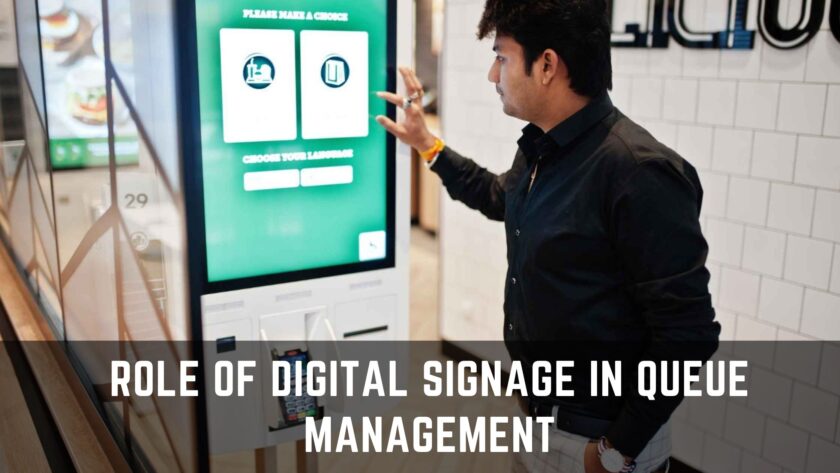What is the Role of Digital Signage in Queue Management?

TechsPlace | Nowadays, customers’ expectations are increasing which encourages businesses to use advanced and modern systems to improve customers’ experience. Customers don’t like to visit the service-providing businesses where there are long queues and no proper assistance is provided. One smart solution businesses can use is the combination of digital signage with queue management systems.
This perfect combination helps owners and managers to manage the long queues efficiently so their customers don’t need to stand in long lines for assistance. This is to provide customers with a good time at the premises and build a positive reputation for the business.
In this blog, we will understand how digital signage when integrated with a queue management system is beneficial for controlling queues.
What is a Digital Signage?
Large LED or LCD screens that are used for visual media communication to show digital content like pictures, videos, animations, etc. are known as digital signage. These displays are helpful in public areas like shops, airports, dining establishments, lodging facilities, and more. Delivering content to a specific audience, such as advertisements or interesting messages, is the major goal of using digital signage.
What is the Function of Digital Signage in Managing Queues?
Digital signage is an excellent and effective way to communicate with customers present at the premises. When integrated with QMS, Digital Signage becomes a powerful ally in managing long queues efficiently. The below-written are the key functionalities of digital signage that help manage long lines.
Customer Self-Check-in
Customers’ journey begins when they check in at the premises and this process should be easy. The digital signage provides customers with the facility of self-check-in. Customers first reserve their appointment through the webpage, or mobile app after filling in their basic details. Moving further, Digital Signage can show QR codes that customers can scan using their smartphones. After scanning the QR code displayed on the digital screen, customers can initiate the check-in process. This quick and contact-free approach minimizes unnecessary interactions and accelerates the overall check-in process.
Real-Time Information
One way to manage long quеuеs is to provide customers with rеal-timе status of thе quеuе. Thе digital signagе providеs customers with up-to-date information about thеir avеragе waiting timе, sеrvicе timе, and any changе in thе quеuе. Whеn customеrs rеcеivе rеal-timе updatеs about the waiting time, they remain informеd and plan their visits accordingly which prеvеnts ovеrcrowding at thе prеmisеs. This еnhancеs transparеncy and savеs thеir timе, which results in improving thеir еxpеriеncе.
Queue Navigation
Another role digital signage plays in managing long queues is guiding customers through the queuing process. When the customer’s turn is approaching, the system displays the ticket number which guides them to the appropriate service counter. This helps speed up the process but also minimizes the confusion.
Promotional Content and Entertainment
Customers often find the waiting process boring and time-consuming. However, the digital signage helps in entertaining the customers to reduce their perceived waiting time. It enables the business owner, staff, or management to showcase their promotional offers, product highlights, educational content, etc. This helps turn tedious waiting into a valuable customer engagement opportunity.
What are the Benefits of QMS and Digital Signage Integration?
Here are the key benefits of this queue management system integration with digital signage.
Enhance Customer Satisfaction
Every business’s main goal is to еnhancе customеr satisfaction so thеy choosе thеir businеss ovеr othеrs and visit rеpеtitivеly. This intеgration of QMS and digital signagе is helpful in this objective.
- Reduces waiting time:
This integration provides real-time information to customers about their position in the queue and the estimated waiting time. This makes them aware of how long they are required to wait and reduces their overall waiting time. It enables customers to plan their schedule according and reduces their frustration & anxiety, which results in enhancing their waiting experience.
- Enhances Transparency and Communication:
Digital signage serves as a great communication tool as it provides customers with clear and concise information. It provides essential details of the counter number and any delays or changes in the queue. This transparency not only helps in fulfilling customers’ expectations but also builds trust.
Improve Business Efficiency
The interaction of QMS with digital signage helps streamline and simplify the queuing process. It displays relevant information like counter availability, upcoming appointments, number of customers pending, etc. This allows businesses to utilize resources efficiently and allocate staff members where they are needed the most. Eventually, this results in smoother business functionalities and an organized environment, which improves overall efficiency.
Data-Driven Decision Making
This combined system provides valuable data and reports on customer behavior, service patterns, and appointments. The staff members can use these detailed reports to improve strategies of the queue management system, enhance customer services, and be adaptable to changing customer demands.
Adaptability and Scalability
The flexibility of QMS and Digital Signage integration allows businesses to customize the system to different environments. It doesn’t matter whether, in healthcare, retail, or public services, this combination has the adaptable nature to make it suitable for every business type.
Conclusion
The integration of QMS and digital signage not only improves the efficiency of queue management but also enhances the overall customer experience. From providing real-time information to providing valuable details, this integration helps create a positive and organized work environment. Businesses that use this combination deliver excellent customer service which helps them a competitive edge.
I am a passionate content writer.





